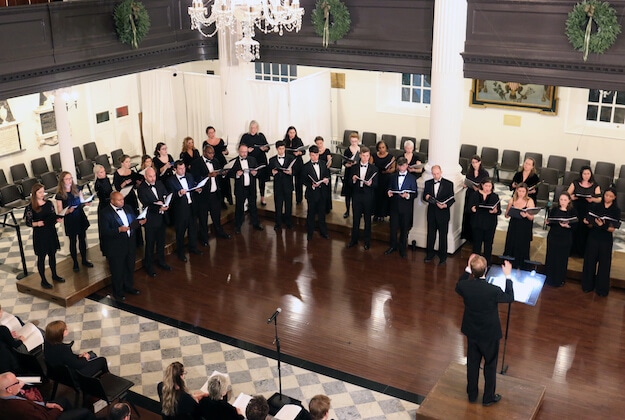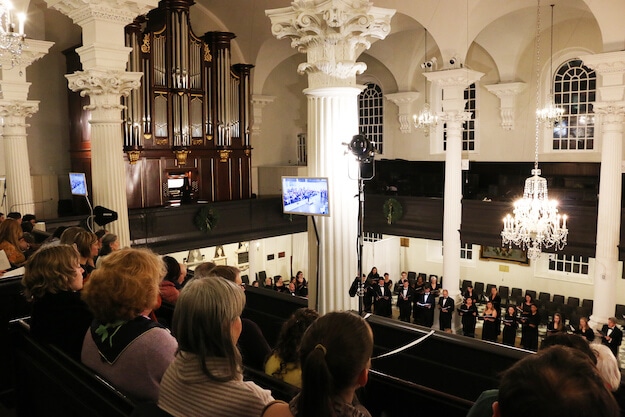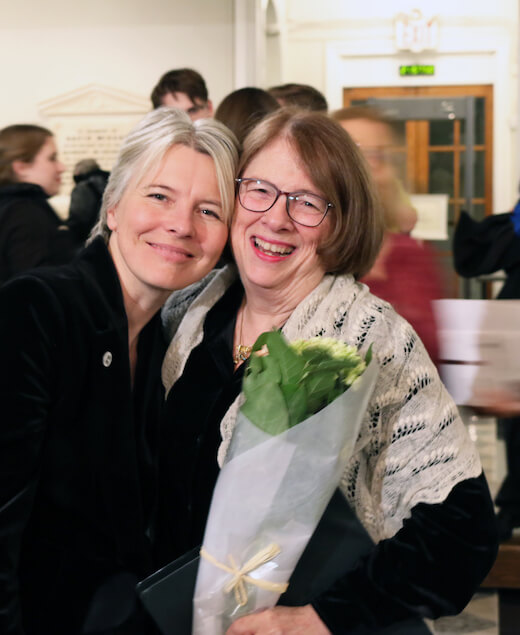
Photos by Siiri Lind
It would be difficult for any American choir to sing in Estonian, let alone choose Estonian repertoire to celebrate the 100-year anniversary of Estonia’s independence.
As 2018 draws to a close, it was most appropriate and deeply touching to attend the Downtown Voices Concert, “Voices Over Tallinn”, at St. Paul’s Chapel on November 30th. The choir is comprised of singers from the metro area and from the Choir of Trinity Wall Street forming a beautifully balanced ensemble. They have performed a wide variety of repertoire from Beethoven to Ginastera, to Phillip Glass. So it comes as no surprise that this fine choir and its outstanding conductor, Stephen Sands, would have disco-vered Estonian music, and undertaken the arduous task of singing in the original language.

Our thanks go to musicologist Mimi S. Daitz, who has also written a wonderful book about Veljo Tormis and provided the conductor with Estonian repertoire to choose from, helped with the pronunciation and program, etc. Stephen Sands, known as an innovative conductor, singer and educator, created a quilt of some of the most renowned Estonian composers. He charmingly stated that it was a challenging task to choose some repertoire while leaving out other brilliant Estonian composers. Veljo Tormis was very well represented, as was Arvo Pärt. Cyrillus Kreek and Eduard Tubin were given their due, and Pärt Uusberg got a nod as a representative of the younger generation. More puzzling was the choice of Ester Mägi, a respected composer in Estonia. Suitsupääsuke (Barn Swallow) was a charming piece, but hardly worthy of a place in this concert celebrating the best Estonia has to offer. Erkki Sven-Tüür or Helena Tulve might have been better choices, not to mention Rudolf Tobias with his vast choral repertoire.

From left: Jaanika Peerna, the Cultural Coordinator at Estonian Consulate General in New York congratulates musicologist Mimi S. Daitz after the successful concert. Photos by Siiri Lind.
What was apparent in this concert was the spirit of Estonian choral music, so original and unique in the global landscape of choral singing. Estonian music is never far from nature, and the language itself imitates the sounds of nature. What is most remarkable, however, is the sincerity and deep humility of the Estonian sound. Magical minimalism returned to its roots through Pärt and Tormis, although Tobias, Kreek and Tubin, who embraced large forms, also incorporated the ancient modes and melodies of Estonia. Tormis famously said: “It is not I who makes use of folk music, but folk music that makes use of me”. Tobias, upon returning to Estonia from Paris, would first and foremost bend to kiss the soil. “It is here that I get my sustenance, from my “kodumaa” (homeland).
The concert ended with Gustav Ernesaks’, Mu Isamaa on minu arm. The large audience on this rainy night appreciatively understood the rising to their feet of the Estonians in the crowd, led by the Estonian Consulate. How many song festivals have had choirs sing this piece with tears streaming down their cheeks?
Independence cost this small, courageous country dearly — but singing has set it free.
Maaja Roos
















